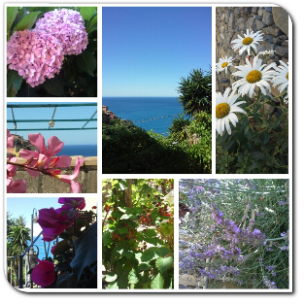Sole Terra Mare
Menu principale:



The Cinque TerreThe Cinque Terre: a realm where the heady scents of untamed nature have gone unchanged through the centuries. Visitors here will find five medieval villages, or “borghi” suspended between the sea and the land, clinging to the sheer cliffs where the luxuriant green hills meet the waves. They will discover the history of a people who have battled with this difficult terrain upon a coastline where man has worked with nature to create one of the most breathtaking landscapes in the world, terracing the hills to cultivate their vines the inhabitants have created a masterpiece of natural harmony in which to live.Spending time amongst them you can observe and understand a way of life, the life that moves along these dry stone walls, through these vineyards, in the nets of the fishermen, down the steep slopes of the plunging valleys and along their paths.You may chose to dive into the sea or to climb the hills, to stroll through the ancient alleys of the towns or to take a trip out on a boat, to make a pilgrimage to one of the sanctuaries or to savour a seafood lunch.Riomaggiore, Manarola, Corniglia, Vernazza and Monterosso are the names of these unique villages in this unforgettable landscape where from time immemorial fishermen and farmers have toiled and worked together, treading the paths from one town to the next along which they carry their trade and their news.Out of the heart of this magnificent territory rises Corniglia, built on a rocky promontory high above the sea surrounded by fertile vineyards.The origins of the village date back probably to Roman times; on vessels of wine found at Pompei the name of Cornelia can be read, suggesting that the ill-fated inhabitants were enjoying the wine from a colony in these vineyards.The character of this village is linked more strongly to the land than to the sea and in nature resembles more the inland villages. The parish church of San Pietro is one of the most interesting Ligurian Gothic buildings in the Cinque Terre, built in 1334 on the remains of a XI century chapel it has been subsequently modified and inside displays baroque décor. Beneath the sacristy there is a building with gothic arches made from black stone which tradition holds to be the ancient postal station of the Fieschi family.Where to stay…… If you wish to lose yourself in this haven of peace and tranquillity, caught between the past, the present and the glint of a future, you may stay at Signora Eleanora Rossi’s SOLE TERRA MARE residence. SOLE and MARE are two bedsit flats, while TERRA is a room with a private bathroom. Each has been restored with love and respect for the territory, its inhabitants and the stipulations of the National Park of the Cinque Terre which aims to preserve the unique character of the villages.
Le cinque terreUn regno di natura e profumi selvaggi immutati nel corso degli anni.Visitarle significa scoprire cinque borghi o terre medievali sospesi tra mare e terra, aggrappati su scogliere a strapiombo sul mare e circondati da colline verdissime, significa conoscere la storia di chi da secoli lotta con un territorio difficile, costituito da una costa impervia dove la natura e l'uomo hanno creato uno scenario tra i più belli al mondo grazie ai terrazzamenti costruiti per coltivare le viti, un vero e proprio capolavoro e in cui uomo e natura convivono, da sempre, in straordinaria armonia. Trascorrendo del tempo in questi luoghi si avrà l'opportunità di apprendere e apprezzare la cultura dei muretti a secco e della vigna, dei pescatori e delle loro reti, delle scoscese valli e dei loro sentieri.Chi arriva nelle cinque terre può scegliere tra un tuffo in mare o un'arrampicata sui colli, tra una passeggiata nei carruggi o una gita in barca, ad un pellegrinaggio o a un pranzo a base di pesce.In questo luogo indimenticale sorgono Riomaggiore, Manarola, Corniglia, Vernazza e Monterosso, caratteristici borghi di pescatori e agricoltori che, fin dai tempi antichi, lavorano queste terre e che hanno creato linee di comunicazione, come i sentieri che collegano ogni paese all'altro e nel passato usati come vie di commercio e comunicazione.Al centro di questa meravigliosa area sorge Corniglia situata su un promontorio roccioso a picco sul mare, ai margini di una conca intensamente coltivata a vigneti.Le origini del paese sono probabilmente romane, il nome Cornelia, infatti, si legge su alcune anfore vinarie scoperte negli scavi di Pompei, e ciò viene portato come prova per dimostrare che la località ha preso il nome da coloniali romani.Più legata al territorio che al mare, questo piccolo centro ha destinazione agricola e presenta una tipologia urbana simile a quella dei nuclei rurali dell'entroterra. La parrocchiale di San Pietro è uno dei più interessanti monumenti gotico-liguri delle Cinque Terre, edificata nel 1334 sui resti di una cappella del XI secolo è stata in seguito rimaneggiata e presenta all'interno sovrapposizioni barocche. Sotto il sagrato vi è un edificio con archi gotici in pietra nera che la tradizione identifica con l'antica stazione di posta della famiglia Fieschi.Se desiderate immergervi in questa sensazione di pace e tranquillità, sospesa tra passato, presente e un pizzico di futuro, potete ritrovarla in una struttura ricettiva molto attenta al rispetto del territorio, di chi vi abita e dei requisiti regolamentati dal Parco Nazionale delle 5 Terre nell'ambito della sostenibilità ambientale. Il nome di questa struttura è SOLE TERRA MARE di Rossi Eleonora, composta da due monolocali, SOLE e MARE, e una camera con bagno, TERRA

For booking and information / Per prenotazioni e informazioni
Mobile: +39 3405460781
Mobile: +39 3477301928
